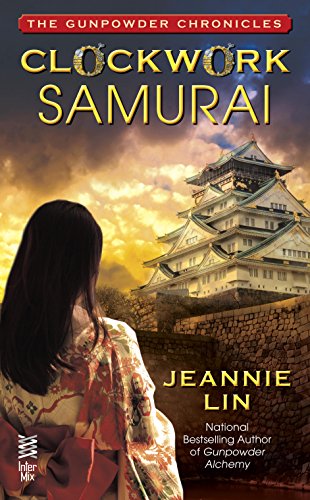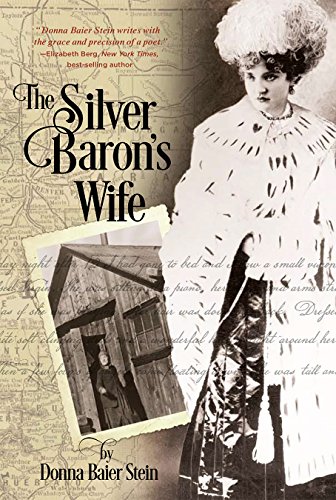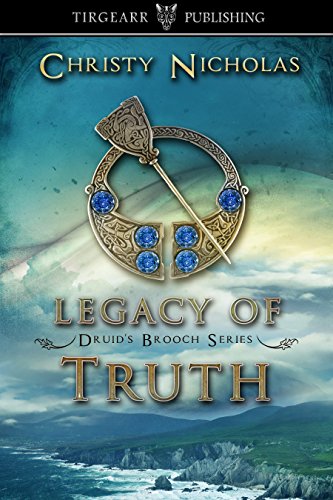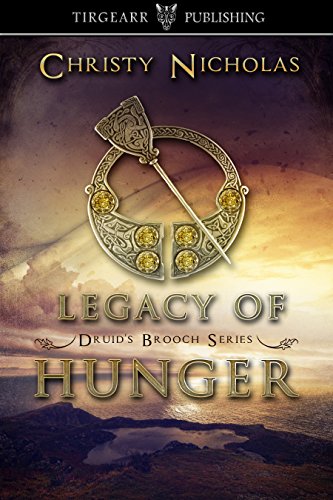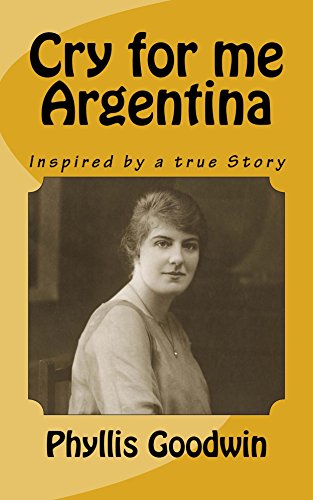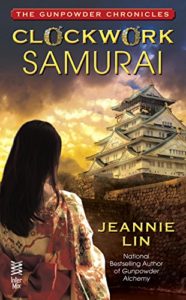 211 pages $2.99 on Kindle
211 pages $2.99 on Kindle
Jeannie Lin is best known for her romance novels, historical romances set in Tang Dynasty China. I have not read those, but have now read the first two books in her Gunpowder Chronicles steampunk series set in the Opium Wars era in China in the mid-19th century. I enjoyed both, and look forward to seeing more books in the series, now that she has set up the world and her characters so well.
Clockwork Samurai picks up soon after Gunpowder Alchemy, with our heroes from Gunpowder Alchemy, Jin Soling and Chen Chang-wei, now at work in the Imperial Palace in the Forbidden City, Soling as an Imperial physician and Chang-wei as a senior engineer in the Ministry of Engineering. An audacious plan to seek a Japanese alliance against the British, who are rotting China from within with opium, tainted and otherwise, is ordered into action by the new Emperor. Soling and Chang-wei are dispatched to Japan, an island nation closed against all foreigners for over two centuries. Action, intrigue, reunions and shifting alliances ensue.
Ninjas! Clockwork Samurai! Dragon airships! And mechanical Chinese herb mixing machines and other delightful Asian-inflected steampunk elements enliven the mix. I don’t want to give the plot away except to notice that there is a great deal of tromping around in the Japanese countryside suffering rather frequent attacks by assassins in well-written bouts of action that reminds me oddly enough of the second book in the Lord of the Rings trilogy where Merry and Pippin as Team A and Frodo and Sam as Team B spend much of the book tramping here and there to get to various places under rather frequent attack by orcs and other disagreeables, an shortcoming remedied in the Two Towers film version by spending the film time on less tramping and one big hellacious siege battle. I kind of got to the end of the book still looking for the climactic “boss fight” after all the tramping. The author set up a lot, whether it be the danger of the tainted opium, the position of the Japanese Shogunate on foreign politics, the position of the Chinese empire, but that the story didn’t quite push any of these elements as far as they could have been pushed or get to resolution or payoff on any of them. I found this underdevelopment by a terrific writer a crime of omission in what is otherwise a great read.
For it is a great read, my quibbles aside, and head and shoulders above much else that is available in the steampunk genre world, well-written in graceful yet concrete prose. For Lin’s adventure yarn also brings in wonderful elements of romance in the slow-simmering and very Chinese romance brewing over two books between Soling and Chang-wei, the backdrop of the urgent and tumultuous struggle for survival between the great Far Eastern powers and the rising Western Powers that marked the mid-19th century, and a growing flock of well-drawn characters in what is fast-becoming an epic scale world. Lin’s characters are individual and unique, reflecting their Chinese status-conscious culture here, or their Japanese dedication to honor and duty there.
The romance element is strong, befitting Lin’s background in historical romance. While I do suspect Lin came up with more excuses for Soling and Chang-wei to be thrown together in private, with Chang-wei’s shirt off to reveal nicely muscled masculine flesh so Soling can play doctor on him, than were absolutely necessary for plot requirements, the occasional fiery chance touches and shivers and moments of snuggling were welcome and let the Western reader accustomed to more sexual action understand that these two are in to each other even if they spend most of their time stoically ignoring each other. Lin’s grasp of the period history and culture is strong and sure, and her tale provides a great introduction to the non-Asia expert on the period and place where she has set her story.
I look forward to seeing Soling and Chang-wei continue their romance and their careers under the capricious new Emperor, and hope they are able to forge the alliance with Japan that they seek with their new friends and…no, I shan’t give it away. Suffice it to say that the new allies and technologies they found in Japan set up many new exciting possibilities for the next installments in the Gunpowder Chronicles. I look forward to reading more from Jeannie Lin. I recommend the book to action-adventure fans, historical romance fans, steampunk fans looking for something outside Victorian England and the American Wild West and anyone who enjoys a well-written yarn.
